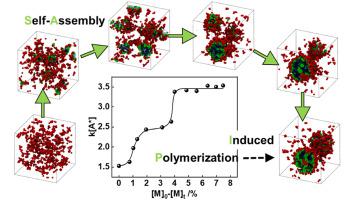Polymer ( IF 4.1 ) Pub Date : 2022-11-19 , DOI: 10.1016/j.polymer.2022.125530 Song Zuo , Weisheng Feng , Fan Liu , Xuepei Xu , Xinfeng Tao , Liquan Wang , Honglai Liu , Shaoliang Lin

|
Side-chain liquid crystal copolymers can self-assemble into dispersed assemblies effectively with the polymerization-induced self-assembly (PISA) technique. However, the synergy of polymerization and self-assembly result in undefined self-assembly behavior and polymerization kinetics. We explored the PISA behavior of side-chain liquid crystal copolymers in selective solvents by combining dissipative particle dynamics simulation and a probability-based reaction model. It was found that the morphologies of assemblies depend on the PISA time, copolymer concentrations, and various structural parameters. The polymerization exhibits three stages with different reaction constants during the PISA, achieving low polydispersity of the produced copolymers. The comparison with experiments demonstrated that the simulation could capture the essential characteristics of PISA. This study can help fundamentally understand the PISA behavior of side-chain liquid crystal copolymers.
中文翻译:

耗散粒子动力学模拟的侧链液晶共聚物的聚合诱导自组装
侧链液晶共聚物可以通过聚合诱导自组装(PISA)技术有效地自组装成分散的组件。然而,聚合和自组装的协同作用导致不确定的自组装行为和聚合动力学。我们通过结合耗散粒子动力学模拟和基于概率的反应模型探索了侧链液晶共聚物在选择性溶剂中的 PISA 行为。结果发现,组装体的形态取决于 PISA 时间、共聚物浓度和各种结构参数。在 PISA 期间,聚合呈现出具有不同反应常数的三个阶段,从而实现了所生产共聚物的低多分散性。与实验的比较表明,模拟可以捕捉到 PISA 的基本特征。该研究有助于从根本上了解侧链液晶共聚物的 PISA 行为。











































 京公网安备 11010802027423号
京公网安备 11010802027423号